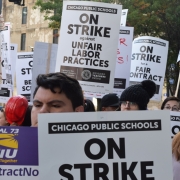In economics, branding serves an important purpose. Brands allow people to economize on knowledge, a scarce resource. We make decisions with imperfect information, and brand labeling and trademarks help us navigate these decisions. As Thomas Sowell writes:
When you drive into a town you have never seen before and want to get some gasoline for your car or to eat a hamburger, you have no direct way of knowing what is in the gasoline that some stranger at the filling station is putting into your tank or what is in the hamburger that another stranger is cooking for you to eat at a roadside stand that you have never seen before. But, if the filling station’s sign says Chevron and the restaurant’s sign says McDonald’s, then you don’t worry about it.
He goes on to add that “brand names are substitutes for specific knowledge.”
You don’t know much about the particular bottle of ketchup you may be buying—the quality of the factory it was produced in, the farmer who grew the tomatoes, or the recipe used—but if it says Heinz on the label, you have a good idea of what you’re going to get. The need to economize on knowledge is so important that in the Soviet Union, people began to learn how to read barcodes to know whether or not they were getting products from reliable factories.
In customer service industries, this is also the purpose of a uniform. Customers can quickly identify the person they need to talk to in a retail environment, and the uniform conveys certain expectations. The electronic retailer Best Buy dresses its computer technicians, called the “Geek Squad,” in comically cliché “geek” uniforms—white shirts and black clip-on ties—in an attempt to help customers distinguish the employees with specialized computer knowledge from those who sell televisions.
But brand names, trademarks, and uniforms don’t always convey the information that companies want them to convey. For instance, if a customer had a bad experience with an incompetent Geek Squad agent, they may see the uniform as an indicator of somebody whose computer advice should not be trusted. Similarly, McDonald’s famous golden arches may inform a potential customer about the consistent quality of their hamburgers, as Sowell points out, but some consumers may see this as a sign of where not to eat. People always economize on information, but not necessarily in the way that companies hope.
This is why companies are so protective of their brand and trademarks. Any dilution of their reputation hurts the value of their product in the eyes of the consumer, not because the quality itself is lowered, but because when consumers face greater uncertainty in their economic decisions they are less likely to buy a given product.
As in the customer service industry, a police officer’s uniform conveys information to civilians. In the idealized vision of police, the uniform should convey security. Most of us were taught as children that if we get separated from our parents, we should avoid strangers but find a police officer. Even though the officer is also a stranger, children are taught to see the police uniform as an indicator of trustworthiness in the potentially dangerous uncertainty of human interaction.
This example also illustrates Sowell’s observation that brands are substitutes for specific knowledge. We do not know whether any individual is trustworthy or not, but, ideally, a police uniform should be a consistent marker of trustworthiness. But the converse may also be true. Just as I avoid the McDonald’s arches because I don’t like their food, the information conveyed by a police uniform is not always consistent with the idealized vision of police.
Any given police officer may be a kind, helpful person who only wants to serve and protect, as the police mantra claims, or he may be a scoundrel who enjoys asserting violent authority over others. This is the uncertainty that people face every time they interact with a police officer. But the uniform does convey some consistent, reliable knowledge that helps people know whether to feel safe or threatened.
For instance, thanks to the doctrine of qualified immunity, all police officers are immune from the consequences of excessive and unnecessary force, even in cases that result in the death of unarmed, nonresisting civilians. Certainly not all police take advantage of this immunity. Social media loves heartwarming stories of cops helping people or simply showing kindness. Many cops are not needlessly violent—in fact, it’s likely that the vast majority of them are not. But the uniform does not inform civilians of whether or not a cop will be gracious or abusive; it merely informs us that if they want to commit violence they can do so without fearing the consequences that the rest of us would face.
The result is that, in contradistinction to what we are taught as children, many people rationally feel unsafe interacting with a police officer than they do with a random civilian stranger. I stress the word “rationally” because their feeling of insecurity is not the product of a delusional prejudice or false propaganda, but rather of the reasonable weighing of possibilities in the face of uncertainty. They do not have knowledge of the specific officer’s temperament and character, but they do have knowledge of the legal immunity that will protect the cop if he abuses his authority.
Similarly, practices such as civil asset forfeiture become attached to the police uniform in the minds of civilians. Many cops, I’m sure, would never steal a person’s life savings or confiscate their legally owned property just because the law allows them to do so—but the law does allow them to. In the face of uncertainty, this is the knowledge that people have. If somebody has cash on their person or in their vehicle, as people often do when buying a used car off the internet or conducting a similar legitimate transaction, they don’t know whether a given cop will steal their money—they only know that the officer can.
And just as when a company hurts their brand by consistently providing poor service or a disappointing product, the frequent stories of police brutality and extrajudicial killings re-create the image of police conveyed by the uniform. The lack of accountability in these stories amplifies the effect. The actions of individual officers, even if we accept that they are anecdotal and not representative of the majority, convey information that people rationally attach to the uniform of all cops.
In short, people increasingly feel unsafe around police, because, frankly, it would be irrational to feel otherwise. It is impossible for anybody to know what a given cop will do, but thanks to the perverse incentive structures created by courts and tough-on-crime legislators, as well as the poor behavior of individual officers, who are virtually never brought to justice, people make their judgments of the police based on what officers can do. As long as we live in a world of imperfect information, it would be silly to expect people to make assumptions about police according to any other standard.
Chris Calton is an economic historian. He is writer and host of the Historical Controversies podcast. This article first appeared at mises.org.









